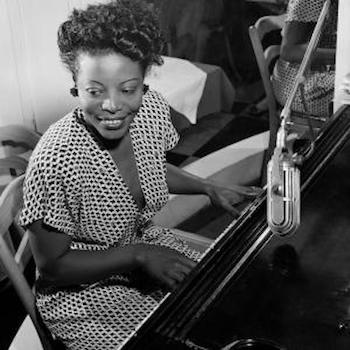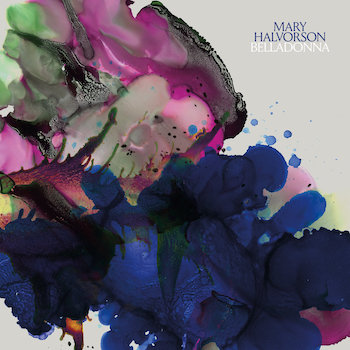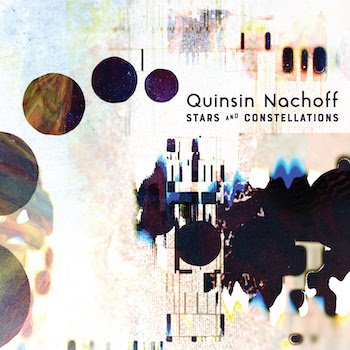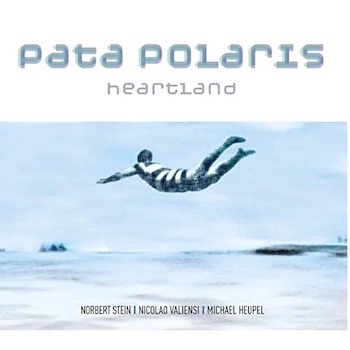Jazz Commentary: Four Recent Composer-Driven Jazz Releases — New Wine in New Bottles
By Steve Elman
Four recent releases illustrate what can happen when the only limits are the imagination of the composer and the passion of the performers.

Mary Lou Williams. Photo: William Gottlieb
Not long ago in the Fuse, I offered an essay on music in “The Place Between” classical and jazz. It’s been gratifying to see that each new year seems to bring another crop of bold adventures in combining formal composition with improvised music. Seven recent releases illustrate what can happen when the only limits are the imagination of the composer and the passion of the performers.
In this post, I’ll discuss four projects with instrumentation that is unconventional in the jazz world — a landmark recording of a major orchestral work by Mary Lou Williams, a creative trio for winds featuring the euphonium, and two recordings that engage with string quartets in fascinating ways. In the second post, I’ll look at three that use more conventional instrumentation.
Pride of place here must belong to the new recording of Zodiac Suite (Mack Avenue, 2023), composed in 1945 by Mary Lou Williams. It is an invaluable addition to the catalog of works that bridge the genre gap between jazz and classical. Although there are many hybrid works that precede “Zodiac”‘s composition, few if any of them make improvisation integral to their performance, and there is not another one in the literature for a full decade — Dana Suesse’s almost-unknown “Jazz Concerto in D Major for Combo and Orchestra” (1955). Even Duke Ellington’s piano concerto, “New World A-Coming” (1943), was designed to be performed as written; the composer did no more than embellish the piano parts when he played it. Williams suffered the same disappointments that Ellington suffered when his symphony “Black, Brown, and Beige” (also from 1943) premiered — disparaging reviews, fragmentary performances, misunderstanding, and failure to deal with the work on its own terms. So a recording of this music as Williams wanted it to be, a 12-part suite of miniatures for orchestra with jazz soloists, is long overdue.
Pianist Aaron Diehl has been a champion for “Zodiac,” playing it with the Milwaukee Symphony and the New York Philharmonic in the spring of this year. The version on this new recording is a collaboration between Diehl’s trio and The Knights, the Brooklyn-based new music ensemble that ranges in size from chamber to full-size orchestra as works require. For this recording, they fielded a group of 12 strings, three winds, and three brass, which gives the work a well-balanced if not quite symphony-sized realization. There is much more valuable information about the work and its genesis online, including its Wikipedia entry, a New York Times piece by Seth Coulter Wells, and an information resources page from the Milwaukee Symphony’s website.
Engaging with this music as Williams wanted it to be is a thrill. It is not intended as a Gershwin-style grand rhapsody or an Ellingtonian scaling-of-the-heights. It is just what it says it is: a suite — that is, a number of small pieces of individual character built on a theme, which in this case is the 12 signs of the zodiac and their mythic connections. In my view, it is better to hear these pieces as pure music; they do not need the zodiac program to be appreciated as exquisite episodes that speak with eloquence, integrate swing feeling with grace, and present improvised solos that are integral to the music’s development. They are, in fact, an ideal way for a new listener to begin to explore the enormous literature of hybrid works that precede and follow it.
Williams is years ahead of her contemporaries (and even those who come after her) in offering a genuinely original voice in the work — neither post-Gershwin (except in “Capricorn,” where the Gershwin feel is evoked without slavish imitation), post-Ravel (except in parts of “Pisces”), nor post-Ellington (except in “Scorpio,” where Williams elaborates on the Middle-Eastern feel of Ellington’s “Caravan”). “Zodiac” is also not “music of the swing era”; it is as contemporary as any of the other releases I discuss in this post. It is timeless.
 Violinist Colin Jacobsen, concertmaster and co-artistic director of The Knights, has a brief solo, and he plays it beautifully. There are also three guest soloists in addition to pianist Diehl who make brief appearances as improvisers, and a soprano soloist who sings a text in “Pisces,” the final part of the suite. The best is trumpeter Brandon Lee, who is both an individual player and an interpreter sensitive to the nuances of 1940s style; he is given two spots to shine. Evan Christopher brings a lot of Benny Goodman to his clarinet solo in “Gemini” — entirely appropriate, since Williams wrote for Goodman’s band. Nicole Glover is better than adequate on tenor in “Cancer,” giving us a flavor of Coleman Hawkins and Ben Webster, but I miss what a real master like James Carter could have done in that spot.
Violinist Colin Jacobsen, concertmaster and co-artistic director of The Knights, has a brief solo, and he plays it beautifully. There are also three guest soloists in addition to pianist Diehl who make brief appearances as improvisers, and a soprano soloist who sings a text in “Pisces,” the final part of the suite. The best is trumpeter Brandon Lee, who is both an individual player and an interpreter sensitive to the nuances of 1940s style; he is given two spots to shine. Evan Christopher brings a lot of Benny Goodman to his clarinet solo in “Gemini” — entirely appropriate, since Williams wrote for Goodman’s band. Nicole Glover is better than adequate on tenor in “Cancer,” giving us a flavor of Coleman Hawkins and Ben Webster, but I miss what a real master like James Carter could have done in that spot.
The CD package should have given us the text of “Pisces.” The song, placed at the end of the suite, seems to be intended by the composer to provide a point of conclusion, so hearing the words clearly is important. Soprano Mikaela Bennett, sensitive as she is, is obscured a bit by the mix and perhaps by Bennett’s own lack of clarity. I longed for a voice like that of Dawn Upshaw, who handles material like this so beautifully in her performances of Maria Schneider’s songs. What we can understand may reflect some of Mary Lou Williams’s personal philosophy: “Life’s a game … / I don’t mind when sometimes I take a fall / Doesn’t bring me down because all in all / What is living? Taking, giving.”
 Mary Halvorson’s Belladonna (Nonesuch, 2022) has already received a great deal of praise, usually paired with its companion album Amaryllis, as among the best releases of 2022. The encomiums are deserved: both of her 2022 CDs offer music that fascinates on first hearing and repays repeated plays. But Belladonna should be considered (and reconsidered) separately because of its distinctive conception — it consists of five pieces for electric guitar and string quartet, where the composer/guitarist is the only improviser. (In two of the compositions her guitar is enlisted as a sixth overdubbed voice.) Halvorson’s trademark mastery as a technician, using devices to blur her pitches and add watery effects, is set off strikingly by the string playing. She is front and center throughout, as she should be; her voice is distinctive, and you want to hear as much of her thinking as you can. The Minos Quartet plays Halvorson’s music with great feeling throughout, but their role is not as genre-bending as that of the groups in Quinsin Nachoff”s Stars and Constellations (see below). However, in some sections of the CD, Halvorson gives the quartet a measure of the spotlight, with excellent results.
Mary Halvorson’s Belladonna (Nonesuch, 2022) has already received a great deal of praise, usually paired with its companion album Amaryllis, as among the best releases of 2022. The encomiums are deserved: both of her 2022 CDs offer music that fascinates on first hearing and repays repeated plays. But Belladonna should be considered (and reconsidered) separately because of its distinctive conception — it consists of five pieces for electric guitar and string quartet, where the composer/guitarist is the only improviser. (In two of the compositions her guitar is enlisted as a sixth overdubbed voice.) Halvorson’s trademark mastery as a technician, using devices to blur her pitches and add watery effects, is set off strikingly by the string playing. She is front and center throughout, as she should be; her voice is distinctive, and you want to hear as much of her thinking as you can. The Minos Quartet plays Halvorson’s music with great feeling throughout, but their role is not as genre-bending as that of the groups in Quinsin Nachoff”s Stars and Constellations (see below). However, in some sections of the CD, Halvorson gives the quartet a measure of the spotlight, with excellent results.
Halvorson employs a lot of repetition in the lines she writes for the ensemble, and this makes this music much more approachable than it would be if she had chosen longer and more abstract figures. In addition, the pieces generally follow (approximately) a traditional theme-variations-theme form, and that provides some grounding for the conventional jazz listener. Although the entire CD is a delight, “Moonburn” and “Haunted Head” are noteworthy for their openhearted showcase of Halvorson’s harmonic ingenuity; the tonalities never settle into single keys, but they are soulful nonetheless. In addition, the quartet’s chords on these pieces provide pillows for her guitar that enhance, enrich, and clearly inspire.
The zodiac (well, two parts of it) is back on composer-saxophonist Quinsin Nachoff’s Stars and Constellations (Adhyrâopa, 2023) along with three compositions that integrate a tenor-bass-drums trio with string quartet(s). Nachoff works in a modern idiom, without fixed harmonies or song-structures, although some regular rhythm makes an appearance in “Sagittarius.” His music is challenging, but readily approachable if your ears are open. These are through-composed pieces with improvisational sections that veer into free playing, most notably on “Scorpio.” Nachoff handles these materials adeptly, and builds some fascinating structures for forces that usually are seen as timbrally opposed. The two string quartets on this recording (the Bergamot Quartet, on all three pieces, and The Rhythm Method, joining them on “Pendulum”) underline just how brilliantly modern string players rise to any challenges composers present to them. Sonically and interpretatively, these quartets “think with” the jazz trio in realizing Nachoff’s music, making it a unity of conception rather than a competition between contrasting ensembles. The most valuable player here — other than the composer — is the still underappreciated bassist Mark Helias, who is at the heart of the music both composed and improvised; his accuracy of pitch and flexibility of rhythm are vital to the project’s success. Drummer Dan Weiss is less prominent but no less important.
 To my ears the most successful of the three pieces is “Pendulum,” which develops a richly textured energy over its 14 minutes, but the others are satisfying as well. Nachoff’s music is filled with ideas, so many that it is advisable to let your ears rest a bit between the compositions. In this area, Gunther Schuller provides a notable antecedent. His “Conversation” (1965), written for the Modern Jazz Quartet and the Beaux Arts String Quartet, is confident in its silences. It gives listeners space to relax in so they can clearly hear what is going on. Nachoff could learn a bit from Schuller’s approach. Even so, Nachoff’s music invites repeated listening, which is a mark of art that has real depth.
To my ears the most successful of the three pieces is “Pendulum,” which develops a richly textured energy over its 14 minutes, but the others are satisfying as well. Nachoff’s music is filled with ideas, so many that it is advisable to let your ears rest a bit between the compositions. In this area, Gunther Schuller provides a notable antecedent. His “Conversation” (1965), written for the Modern Jazz Quartet and the Beaux Arts String Quartet, is confident in its silences. It gives listeners space to relax in so they can clearly hear what is going on. Nachoff could learn a bit from Schuller’s approach. Even so, Nachoff’s music invites repeated listening, which is a mark of art that has real depth.
For the origins and inspirations of the composer’s music regarding star-mapping, astrological ideas, and mythic figures, have a close look at the liner notes, written by my Fuse colleague Michael Ullman. For me, music this strong stands on its own as pure experience, but the background Ullman provides (along with a useful blow-by-blow on the flow of each piece) will enrich your appreciation.
Heartland (Pata, 2022) is the most intimate of these four releases, a set of eight compositions for tenor sax, euphonium, and flutes by German saxophonist Norbert Stein. Stein’s conception of this wind trio (which he calls Pata Polaris) is conventional (in the classical sense). He has chosen instruments to cover the upper, middle, and lower ranges of his music. On its face, this is akin to contemporary classical chamber music for winds, but it could only be made by players who understand and practice jazz sensitively. Like Halvorson’s, some of Stein’s pieces are in traditional theme-variations-theme form, with the three players improvising between the written sections. Also like Halvorson, Stein uses repetition to give form to his ideas on first hearing; they reveal themselves more clearly as you return for second and third helpings. Each of the eight pieces boasts an admirable tightness — well-defined presentation of ideas, intriguing solo work, sensible development, and a definite sense of finality at the conclusion. Even though each piece is relatively short, Stein supplies plenty of silences, spaces that allow the music to breathe. These are marks of a composer confident in what he has to say and generous in providing valuable “savoring times” for the listener.
 Stein’s colleagues here are stellar. Italian composer-instrumentalist Nicolao Valiensi has a lovely sound on euphonium, and he uses mutes, multiphonics, and hand modifications here to add more colors, even approximating walking bass for a moment or two in “Black Shirt.” The range of his talents makes his presence invaluable. Flutist Michael Heupel (who doubles on alto flute and bass flute) covers the treble clef adeptly and adds a feathery middle-range voice when he goes to his alternate axes; in a few places he also adds some unconventional effects. The composer himself plays tenor with passion and sensitivity, varying his approach from straight to strident to strained as the music demands; his playing has a few rough edges that contrast effectively with the purer tones of his colleagues: he even chuckles and coughs into his saxophone on “Mr. Ping and Mrs. Pong.”
Stein’s colleagues here are stellar. Italian composer-instrumentalist Nicolao Valiensi has a lovely sound on euphonium, and he uses mutes, multiphonics, and hand modifications here to add more colors, even approximating walking bass for a moment or two in “Black Shirt.” The range of his talents makes his presence invaluable. Flutist Michael Heupel (who doubles on alto flute and bass flute) covers the treble clef adeptly and adds a feathery middle-range voice when he goes to his alternate axes; in a few places he also adds some unconventional effects. The composer himself plays tenor with passion and sensitivity, varying his approach from straight to strident to strained as the music demands; his playing has a few rough edges that contrast effectively with the purer tones of his colleagues: he even chuckles and coughs into his saxophone on “Mr. Ping and Mrs. Pong.”
A place to start: the title track, “Heartland,” is among the most directly melodic pieces on the release. One could easily imagine it in a straight-ahead jazz-ballad interpretation. But Stein adds the two other voices to create a sort of Salvation-Army-band effect in the heads. In a second section, the piece slides into a more sedate place. “Lover in Limbo” and “Amber Times” also show off Stein’s ability as a writer of melody.
More:
Pianist Aaron Diehl comes to Boston this week to play a landmark work that I mention above, straddling the worlds of jazz and classical, with the Boston Symphony Orchestra — Duke Ellington’s piano concerto “New World A-Coming.” This is the annual “Opening Night at Symphony” concert, so Diehl has a prestigious spotlight for his work. And it’s yet another sign that music director Andris Nelsons is willing to open up even the most venerable BSO programming to composers of color and composers who write music in the “Place Between.”
Diehl’s regular bassist and drummer (not identified in the BSO advance listings, but possibly David Wong and Aaron Kimmel, who play on “Zodiac Suite”) will underpin the orchestra on “New World.” Then he’ll play a transcription of the Ellington / Billy Strayhorn piano-four-hands tune “Tonk,” with Rudolf Buchbinder (presumably) handling Strayhorn’s part, the less jazzy upper half of the keyboard. The program also includes Buchbinder playing Mozart’s 23rd concerto and Carlos Simon’s “Four Black American Dances.” Unfortunately, there is only one performance, on Saturday, October 7, at 6 p.m, and the only seats left as of this writing are singles.
In January 2022, my colleague Michael Ullman wrote about three more recent composer-driven releases that use string quartets in interesting ways:
Absence by Terrence Blanchard (Blue Note, 2021), Breath by Breath by Fred Hersch (Palmetto, 2021), and Quartet + by Helen Sung (Sunnyside, 2021).
Steve Elman’s more than four decades in New England public radio have included 10 years as a jazz host in the 1970s, five years as a classical host on WBUR in the 1980s, a short stint as senior producer of an arts magazine, 13 years as assistant general manager of WBUR, and fill-in classical host on 99.5 WCRB.
Tagged: Aaron Diehl, Amaryllis, Belladonna, Bergamot Quartet, Heartland, Mack Avenue, Mark Helias, Mary Halvorson, Mary Lou Williams, Nicolao Valiensi, Norbert Stein, Pata Polaris, Quinsin Nachoff, Stars and Constellations, The Knights, The Minos Quartet, The Rhythm Method

A really helpful piece. Excellent descriptions of the Williams and Halvorson (both of which I know), and this makes me want to seek out the others.
Thanks for this insightful and detailed review of the recent Zodiac Suite recording. This Ellington quote sums up her music: “The music of Mary Lou Williams is perpetually contemporary.” Amen to that.